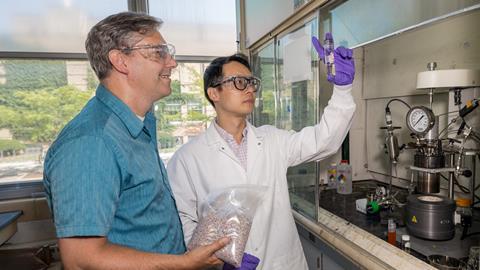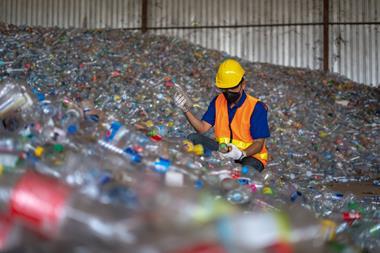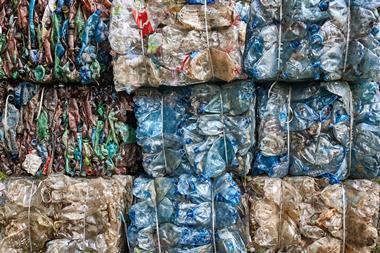New methods of upcycling plastic waste into high-value chemical feedstocks could provide a crucial economic incentive to improve future rates of plastic recycling. By exploiting reactive chemical groups present in degraded plastics, two research teams have developed new ways of preparing valuable products using robust and established chemistry.
Despite huge pressure to address the growing plastic waste problem, recycling rates remain low, with less than 10% of global plastic waste effectively recycled. One of the biggest stumbling blocks is the challenge of developing an economically efficient treatment process. While researchers have developed many different ways to chemically degrade plastics, the cost of operating these processes on scale typically exceeds the value of the repurposed products, making these strategies unfeasible without extensive government subsidies.
With these economic considerations in mind, two teams in the US have now developed alternative chemical upcycling processes that take advantage of existing industrial infrastructures to produce high-value products at low cost.
Exploiting the olefins
Pyrolysis is currently the most common way to recover hydrocarbons from plastic and involves heating the waste to high temperatures. The long polymer chains thermally decompose through a radical mechanism, forming an olefin-rich mixture known as pyrolysis oil which can then be used as a fuel for other industrial processes. However, George Huber from the University of Wisconsin–Madison believes we could extract greater value from this hydrocarbon mixture by exploiting the high proportion of alkenes present in the oil. ‘The whole chemical industry is based on first making an olefin from crude oil and then using that to access all these different chemistries,’ he explains. ‘So why not take advantage of the olefin functionality in pyrolysis oil and use it to make higher-value chemicals rather than just making fuels from it, or feeding it back to a steam cracker?’
The team pyrolysed a mixture of polyethylene and polypropylene post-consumer waste and distilled batches of the pyrolysis oil obtained into cuts of similar-sized alkenes. They subjected these separated fractions to industrial hydroformylation conditions, converting the olefins into aldehydes using carbon monoxide and hydrogen in the presence of a cobalt catalyst. The resulting aldehyde mixtures could then undergo further reactions such as hydrogenation, amination, or oxidation to create higher-value chemical products including diols, amines, and fatty acids. ‘We’re making products that are worth five to 20 times more than the current products of pyrolysis oil,’ says Huber ‘Our most valuable products are the diols – they’re worth $3000–5000 [£2400–4000] per ton and we can make them to 99.99% purity with this technology.’

Controlling pyrolysis
At Virginia Tech, Guoliang Liu was likewise keen to exploit the alkenes produced when plastics thermally decompose. His team was particularly interested in larger hydrocarbon fragments and developed a specialised reaction vessel that applied a temperature gradient over the pyrolysis step to control the size of the breakdown products. ‘The temperature is just high enough to partially break some of the bonds in the polymer chains so we produce short-chain waxes rather than small molecules,’ explains Liu. ‘The products are evaporated and then condensed in a colder region of the vessel, so the thermal gradient controls the extent of chain scission.’
Oxidation over a manganese catalyst in a second vessel then converts these waxy alkenes into long-chain fatty acids – widely used in surfactant products such as soaps and detergents and worth around four times as much as the virgin plastic. ‘Practically, the economic value of recycled products must be higher than the plastic waste to provide sufficient financial incentive for industrial deployment of the recycling processes,’ says Liu. ‘If we can design these processes with an economic mindset, we have a higher likelihood of pushing the technology from the lab to a commercial reality.’
A positive forecast
Susannah Scott, a sustainable catalysis researcher at the University of California Santa Barbara, US was impressed by both teams’ work and is optimistic about the future of chemical recycling solutions. ‘Processes like these are the key to molecular recycling of polymers,’ she says. ‘A strength of both is that the processes are simple, the catalysts are inexpensive and robust, and the products are suitable for a variety of fairly large-scale uses, with the potential to displace fossil fuel-based chemicals. Waste plastics are a hydrocarbon source not much different from crude oil and can eventually be a substitute for oil in a circular carbon economy.’
Both teams have already performed preliminary economic analyses of their methods and forecast that sale of their chemical products would be profitable at the 10,000-ton scale, with larger production plants potentially recouping the initial investment cost within as little as three years. In the immediate future, they will each be working with industrial partners to develop their products and methods at a larger scale, with the ultimate aim of translating these processes into commercial treatments for plastic waste.
References
H Li et al., Science, 2023, DOI: 10.1126/science.adh1853
Z Xu et al., Science, 2023, DOI: 10.1126/science.adh0993

















No comments yet